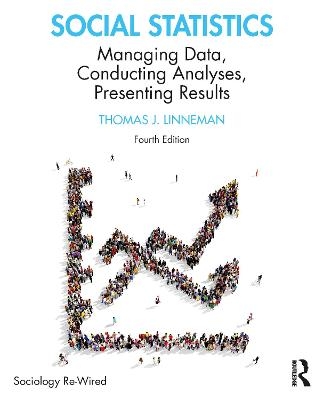
Social Statistics
Routledge (Verlag)
978-1-032-11528-3 (ISBN)
With a clear, engaging writing style and fascinating examples using a variety of real data, this text covers the contemporary statistical techniques that students will encounter in the world of social research. It covers these techniques at an introductory level and carefully guides students through increasingly complex examples without intimidating them. Recurrent examples using four timely topics—health, immigration, income inequality, and everyday harassment—help students understand how the techniques fit together, and how to use the techniques in combination with one another. A superb author-created web resource accompanies the text. How to make clear presentations of research results is also a feature of the text.
New to this edition:
New research shows how the techniques has changed over time in the academic literature, showing students that social scientists really do use the statistical techniques the book teaches and giving them ample motivation to learn the techniques.
Examples throughout the book use the most recent data from the General Social Survey. Four timely topics are threaded throughout the book: immigration, health, income inequality, and everyday harassment. Linneman uses these topics recurrently with different statistical techniques to illustrate how the techniques are related to one another.
The new edition more explicitly emphasizes that the various techniques the students are learning are often used in combination with one another. After introducing a new technique and showing how to use it on its own, Linneman then systematically offers examples of how to combine that technique with techniques students learned in previous chapters.
Most of the literature examples that end each chapter are new and use very recent research from top academic journals (three quarters from 2015 or later, nearly half from 2019). They feature research that covers timely topics such as Black Lives Matter, transgender health, social media, police behavior, and climate change. The SPSS demonstrations are completely redone, both in the book and on the website’s demonstration videos, using more recent data. Linneman applies his experience teaching his own students SPSS (knowing where students get confused) to clarify his explanations in these demonstrations.
Thomas J. Linneman is Professor of Sociology and Faculty Director of Academic Advising at the College of William & Mary. The recipient of several teaching awards, he teaches statistics, social change, sexualities, and the pandemic. His research on teaching statistics recently appeared in the journal Teaching Sociology. After a student posted one of his teaching videos on TikTok and it went viral, a Buzzfeed list named him “Best Professor on the Planet.”
Preface
Acknowledgements
Chapter 1. Life in a Data-Laden Age: Finding and Managing Datasets
Chapter 2. The Art of Visual Storytelling: Creating Accurate Tables and Graphs
Chapter 3. Summarizing Center and Diversity: Basic Descriptive Statistics
Chapter 4. Using Sample Crosstabs to Talk About Populations: The Chi-square Test
Chapter 5. Using a Sample Mean or Proportion to Talk About a Population: Confidence Intervals
Chapter 6. Using Multiple Sample Means to Talk About Populations: T–Tests and ANOVA
Chapter 7. Give me One Good Reason Why: Bivariate Correlation and Regression
Chapter 8. Using Sample Slopes to Talk About Populations: Inference and Regression
Chapter 9. It’s All Relative: Dichotomies as Independent Variables in Regression
Chapter 10. Above and Beyond: The Logic of Controlling and the Power of Nested Regression Models
Chapter 11. Some Slopes are Bigger than Others: Calculating and Interpreting Beta Coefficients
Chapter 12. Different Slopes for Different Folks: Interaction Effects
Chapter 13. Explaining Dichotomous Outcomes: Logistic Regression
Chapter 14. Visualizing Causal Stories: Path Analysis
Chapter 15. Questioning the Greatness of Straightness: Nonlinear Relationships
Chapter 16. Problems and Prospects: Regression Diagnostics, Advanced Techniques, and Where to Go Now
Appendix A: Variables and Indexes from the Datasets Used in the End-of-Chapter Exercises
Appendix B: 100 Articles That Use Statistics in Less than Scary Ways
Appendix C: Statistical Tables
Appendix D: Answers to Odd-Numbered End-of-Chapter Exercises
Bibliography
Glossary/Index
| Erscheinungsdatum | 04.01.2022 |
|---|---|
| Reihe/Serie | Sociology Re-Wired |
| Zusatzinfo | 307 Tables, black and white; 193 Line drawings, black and white; 50 Halftones, black and white; 243 Illustrations, black and white |
| Verlagsort | London |
| Sprache | englisch |
| Maße | 191 x 235 mm |
| Gewicht | 1378 g |
| Themenwelt | Sozialwissenschaften ► Soziologie ► Empirische Sozialforschung |
| ISBN-10 | 1-032-11528-9 / 1032115289 |
| ISBN-13 | 978-1-032-11528-3 / 9781032115283 |
| Zustand | Neuware |
| Haben Sie eine Frage zum Produkt? |
aus dem Bereich


